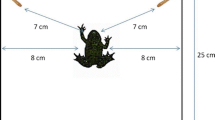Abstract
The ability in animals to count and represent different numbers of objects has received a great deal of attention in the past few decades. Cumulative evidence from comparative studies on number discriminations report obvious analogies among human babies, non-human primates and birds and are consistent with the hypothesis of two distinct and widespread mechanisms, one for counting small numbers (<4) precisely, and one for quantifying large numbers approximately. We investigated the ability to discriminate among different numerosities, in a distantly related species, the mosquitofish, by using the spontaneous choice of a gravid female to join large groups of females as protection from a sexually harassing male. In one experiment, we found that females were able to discriminate between two shoals with a 1:2 numerosity ratio (2 vs. 4, 4 vs. 8 and 8 vs. 16 fish) but failed to discriminate a 2:3 ratio (8 vs. 12 fish). In the second experiment, we studied the ability to discriminate between shoals that differed by one element; females were able to select the larger shoal when the paired numbers were 2 vs. 3 or 3 vs. 4 but not 4 vs. 5 or 5 vs. 6. Our study indicates that numerical abilities in fish are comparable with those of other non-verbal creatures studied; results are in agreement with the hypothesis of the existence of two distinct systems for quantity discrimination in vertebrates.


Similar content being viewed by others
References
Agrillo C, Dadda M, Bisazza A (2006) Sexual harassment influences group choice in female mosquitofish. Ethology 112:592–598
Altmann J (1974) Observational study of behavior: sampling methods. Behaviour 49:227–265
Antell S, Keating D (1983) Perception of numerical invariance in neonates. Child Dev 54:695–701
Barber I, Hazel AW (2001) How strong are familiarity preferences in shoaling fish? Anim Behav 61:975–979
Barber I, Folstad I (2000) Schooling, dusk flight and dance: social organisations as amplifiers of individual quality? Oikos 89:191–194
Bijeljac-Babic R, Bertoncini J, Mehler J (1993) How do 4-day-old infants categorize multisyllabic utterances? Dev Psychol 29:711–721
Bisazza A, Marin G (1995) Sexual selection and sexual size dimorphism in the eastern mosquitofish Gambusia holbrooki (Pisces: Poeciliidae). Ethol. Ecol Evol 7:169–183
Boysen ST (1997) Representation of quantities by apes. Adv Study Behav 26:435–462
Carey S (2001) Evolutionary and ontogenetic foundations of arithmetic. Mind Lang 16:37–55
Clearfield MW, Mix KS (1999) Number versus contour length in infants’ discrimination of small visual sets. Psychol Sci 10:408–411
Cresswell W, Quinn JL (2004) Faced with a choice, sparrowhawks more often attack the more vulnerable prey group. Oikos 104:71–76
Dadda M, Pilastro A, Bisazza A (2005) Male sexual harassment and female schooling behaviour in the eastern mosquitofish. Anim Behav 70:463–471
Feigenson L, Carey S, Hauser MD (2002) The representations underlying infants’ choice of more: object files vs. analog magnitudes. Psychol Sci 13:150–156
Feigenson L, Dehaene S, Spelke E (2004) Core systems of number. Trends Cogn Sci 7:307–314
Feigenson L, Carey S (2005) On the limits of infants’ quantification of small object arrays. Cognition 97:295–313
Griffiths SW, Magurran AE (1997) Familiarity in schooling fish: how long does it take to acquire? Anim Behav 53:945–949
Gallistel CR, Gelman R (2000) Non-verbal numerical cognition: from reals to integers. Trends Cogn Sci 4:59–65
Gallistel CR, Gelman R. (1992) Preverbal and verbal counting and computation. Cognition 44:43–74
Hager MC, Helfman GS (1991) Safety in numbers: shoal size choice by minnows under predatory threat. Behav Ecol Sociobiol 29:271–276
Hamilton WD (1971) Geometry for the selfish herd. J Theor Biol 31:295–311
Hauser MD, Spelke ES (2004) Evolutionary and developmental foundations of human knowledge: A case study of mathematics. In: M Gazzaniga (ed). The cognitive neurosciences, vol 3, MIT Press, Cambridge
Hauser MD, Carey S, Hauser L (2000) Spontaneous number representation in semi-free-ranging rhesus monkeys. Proc R Soc Lond B 267:829–833
Hauser MD, Tsao F, Garcia P, Spelke ES (2003) Evolutionary foundations of number: spontaneous representation of numerical magnitudes by cotton-top tamarins. Proc R Soc Lond B 270:1441–1446
Hoare DJ, Couzin ID, Godin JG, Krause J (2004) Context-dependent group size choice in fish. Anim Behav 67:155–164
Kilian A, Yaman S, Von Fersen L, Güntürkün O (2003) A bottlenose dolphin discriminates visual stimuli differing in numerosity. Learn Behav 31:133–142
Krause J, Ruxton GD (2002) Living in groups. Oxford University Press, New York
Lipton JS, Spelke ES (2003) Origins of number sense: large number discrimination in human infants. Psychol Sci 14:396–401
Lyon BE (2003) Egg recognition and counting reduce costs of avian conspecific brood parasitism. Nature 422:495–499
Marconato A, Bisazza A, Fabris M (1993) The cost of parental care and eggs cannibalism in the river bullhead, Cottus gobio L. (Pisces, Cottidae). Behav Ecol Sociobiol 32:229–237
McComb K, Packer C, Pusey A (1994) Roaring and numerical assessment in contests between groups of female lions, Panthera leo. Anim Behav 47:379–387
Pilastro A, Benetton S, Bisazza A (2003) Female aggregation and male competition reduce the costs of sexual harassment in mosquitofish. Anim Behav 65:1151–1159
Pocklington R, Dill LM (1995) Predation on females or males: who pays for bright male traits? Anim Behav 49:1122–1124
Pritchard VL, Lawrence J, Butlin RK, Krause J (2001) Shoal size in zebrafish, Danio rerio: the influence of shoal size and activity. Anim Behav 62:1085–1088
Pylyshyn ZW, Storm RW (1988) Tracking multiple independent targets: evidence for a parallel tracking mechanism. Spat Vis 3(3):179–197
Roberts WA, Roberts S, Kit KA (2002) Pigeons presented with sequences of light flashes use behavior to count but not to time. J Exp Psychol: Anim Behav Proc 28:137–150
Sulkowski GM, Hauser MD (2001) Can rhesus monkeys spontaneously subtract? Cognition 79:239–262
Trick L, Pylyshyn ZW (1994) Why are small and large numbers enumerated differently? A limited capacity preattentive stage in vision. Psychol Rev 101:80–102
Uller C, Huntley-Fenner G, Carey S, Klatt L (1999) What representations might underlie infant numerical knowledge? Cogn Dev 14:1–36
Uller C, Hauser MD, Carey S (2001) Spontaneous representation of number in cotton-top tamarins (Saguinus oedipus). J Comp Psychol 115:248–257
Uller C, Jaeger R, Guidry G, Martin C (2003) Salamanders (Plethodon cinereus) go for more: rudiments of number in an amphibian. Anim Cogn 6:105–112
West RE, Young RJ (2002) Do domestic dogs show any evidence of being able to count? Anim Cogn 5:183–186
Winn K (2000) Findings of addition and subtraction in infants are robust and consistent: reply to Wakeley, Rivera, and Langer. Child Dev 71(6):1535–1536
Xu F, Spelke ES (2000) Large number discrimination in 6-month-old infants. Cognition 74:B1–B11
Acknowledgements
The authors would like to thank Marc D. Hauser, William D. Hopkins, Marco Zorzi, Catherine O’Hanlon and two anonymous referees for valuable comments on the manuscript. We are grateful to Letizia Frassine and Marilena Giuliano for the help with the experiments. This study was supported by research grants of University of Padova to AB. The reported experiments comply with all laws of the country (Italy) in which they were performed.
Author information
Authors and Affiliations
Corresponding author
Rights and permissions
About this article
Cite this article
Agrillo, C., Dadda, M. & Bisazza, A. Quantity discrimination in female mosquitofish. Anim Cogn 10, 63–70 (2007). https://doi.org/10.1007/s10071-006-0036-5
Received:
Revised:
Accepted:
Published:
Issue Date:
DOI: https://doi.org/10.1007/s10071-006-0036-5




